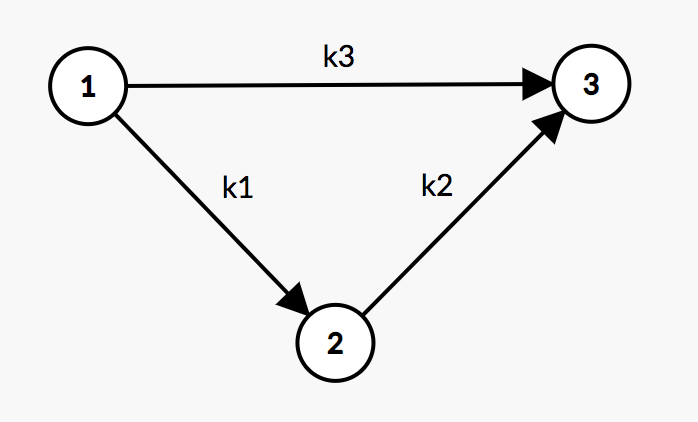Layout
Like everyone else, cows like to stand close to their friends when queuing for feed. FJ has N (2 <= N <= 1,000) cows numbered 1..N standing along a straight line waiting for feed. The cows are standing in the same order as they are numbered, and since they can be rather pushy, it is possible that two or more cows can line up at exactly the same location (that is, if we think of each cow as being located at some coordinate on a number line, then it is possible for two or more cows to share the same coordinate).
Some cows like each other and want to be within a certain distance of each other in line. Some really dislike each other and want to be separated by at least a certain distance. A list of ML (1 <= ML <= 10,000) constraints describes which cows like each other and the maximum distance by which they may be separated; a subsequent list of MD constraints (1 <= MD <= 10,000) tells which cows dislike each other and the minimum distance by which they must be separated.
Your job is to compute, if possible, the maximum possible distance between cow 1 and cow N that satisfies the distance constraints.
Input
Line 1: Three space-separated integers: N, ML, and MD.
Lines 2..ML+1: Each line contains three space-separated positive integers: A, B, and D, with 1 <= A < B <= N. Cows A and B must be at most D (1 <= D <= 1,000,000) apart.
Lines ML+2..ML+MD+1: Each line contains three space-separated positive integers: A, B, and D, with 1 <= A < B <= N. Cows A and B must be at least D (1 <= D <= 1,000,000) apart.
Output
Line 1: A single integer. If no line-up is possible, output -1. If cows 1 and N can be arbitrarily far apart, output -2. Otherwise output the greatest possible distance between cows 1 and N.
Sample Input
4 2 1
1 3 10
2 4 20
2 3 3Sample Output
27Hint
Explanation of the sample:
There are 4 cows. Cows #1 and #3 must be no more than 10 units apart, cows #2 and #4 must be no more than 20 units apart, and cows #2 and #3 dislike each other and must be no fewer than 3 units apart.
The best layout, in terms of coordinates on a number line, is to put cow #1 at 0, cow #2 at 7, cow #3 at 10, and cow #4 at 27.
链接
https://cn.vjudge.net/problem/POJ-3169【为什么是vjudge的链接呢,因为POJ挂了】
题意
n头奶牛,标号为1到n,排成一列,先给定其中一些奶牛的关系:
- ml,奶牛A和奶牛B的距离小于等于D
- md,奶牛A和奶牛B的距离大于等于D
问符合关系下奶牛1和奶牛n的最大距离,无解输出-1,距离无限大输出-2。
题解
转化为差分约束使用最短路解,具体参考:传送门。
代码
- 未提交POJ、暂挂
#include <iostream>
#include <cstdio>
#include <cstring>
#include <algorithm>
#include <queue>
#include <vector>
using namespace std;
const int inf = 0x3f3f3f3f;
const int maxn = 1010;
struct Edge
{
int from, to;
int dist;
Edge(int _from, int _to, int _dist): from(_from), to(_to), dist(_dist) {}
};
struct BellmanFord // 最短路
{
int n, m;
vector <Edge> edges;
vector <int> G[maxn];
bool inq[maxn];
int d[maxn];
int p[maxn];
int cnt[maxn];
void init(int n)
{
this->n = n;
for (int i = 0; i < n; ++i)
G[i].clear();
edges.clear();
}
void addedge(int from, int to, int dist)
{
edges.push_back(Edge(from, to, dist));
m = edges.size();
G[from].push_back(m - 1);
}
bool negativeCycle()
{
queue <int> Q;
memset(inq, 0, sizeof(inq));
memset(cnt, 0, sizeof(cnt));
for (int i = 0; i < n; ++i)
d[i] = inf;
d[0] = 0;
inq[0] = true;
Q.push(0);
while (!Q.empty())
{
int u = Q.front();
Q.pop();
inq[u] = false;
for (int i = 0; i < G[u].size(); ++i)
{
Edge & e = edges[G[u][i]];
if (d[e.to] > d[u] + e.dist)
{
d[e.to] = d[u] + e.dist;
p[e.to] = G[u][i];
if (!inq[e.to])
{
Q.push(e.to);
inq[e.to] = true;
if (++cnt[e.to] > n)
return true;
}
}
}
}
return false;
}
};
int main()
{
// freopen("/Users/taifu/Codes/NOW/data.in", "r", stdin);
// freopen("/Users/taifu/Codes/NOW/data.out","w",stdout);
int n, ml, md, u, v, w;
BellmanFord bm;
while (scanf("%d%d%d", &n, &ml, &md) != EOF)
{
bm.init(n);
for (int i = 0; i < ml; ++i)
{
scanf("%d%d%d", &u, &v, &w);
u--, v--;
bm.addedge(u, v, w); // u v w
}
for (int i = 0; i < md; ++i)
{
scanf("%d%d%d", &u, &v, &w);
u--, v--;
bm.addedge(v, u, -w); // v u -w
}
bool flag = bm.negativeCycle();
if (!flag)
{
if (bm.d[n-1] == inf) // 距离无限长
printf("-2\n");
else
printf("%d\n", bm.d[n-1]); // 答案
}
else // 存在负权回路
printf("-1\n");
}
return 0;
}贝尔曼福德算法的板子是刘老师小蓝书P332上的,有点小错误(d数组初始化以及s点入队),已修正,本题是在本地测试的官方数据,没有发现错误。
详解(转载自传送门)
1、因为我们要求1号牛和n号牛的最大距离,那么我们希望得到这样一个不等式(假设n==5):①-⑤<=x,那么这个x就是1号牛和n号牛的最大距离。2、那么我们引入一个差分约束系统的相关概念:
差分约束系统问题,能够将问题转化为最短路问题。以下给出转化过程:
假设有这样的三个条件:
$x_1 - x_2 <= k_1 $
$x_2 - x_3 <= k_2$
$x_1 - x_3 <= k_3$
那么我们可以将不等式1和不等式2相加得到:
$x_1 - x_3 <= k_1 + k_2$
$x_1 - x_3 <= k_3$
那么如果想要得到k1和k3的最大差值,那么其实就是取$min(k1+k2, k3)$,其实问题我们可以将问题转化成图论,将k1, k2, k3看成三个点k1, k2, k3,对应三条边的建立就根据三个不等式来建立,那么边权值如何取呢?显然我们想要最大差值,我们就需要取最大值。
那么图可以建立成这样:

那么我们上述过程将不等式1和不等式2相加,然后和不等式3比较值的过程,其实就是最短路计算过程中的判断能否松弛的过程。
那么我们就可以根据不等式建立有向图,然后再通过有向图计算1号点到n号点的最短路,其值就是x1与xn的最大差值。
3、然后我们再回归到这个问题上来。
对应ml条信息:
①牛A和牛B的距离不想超过D,那么建立不等式:posA-posB<=D;加入到图中直接add(A,B,D)即可、
对应md条信息:
②牛A和牛B的距离至少要为D,那么建立不等式:posA-posB>=D,那么我们左右两边同乘-1有:posB-posA<=-D,那么加入到图中add(B,A,-D)即可。
4、图建立好之后直接跑最短路即可。
对应输出:
①如果dis【n】==inf,输出-2;
②否则输出dis【n】;
③如果在跑贝尔曼福德过程中发现了负环,说明问题无解,那么输出-1.
The end.
2018-09-05 星期三